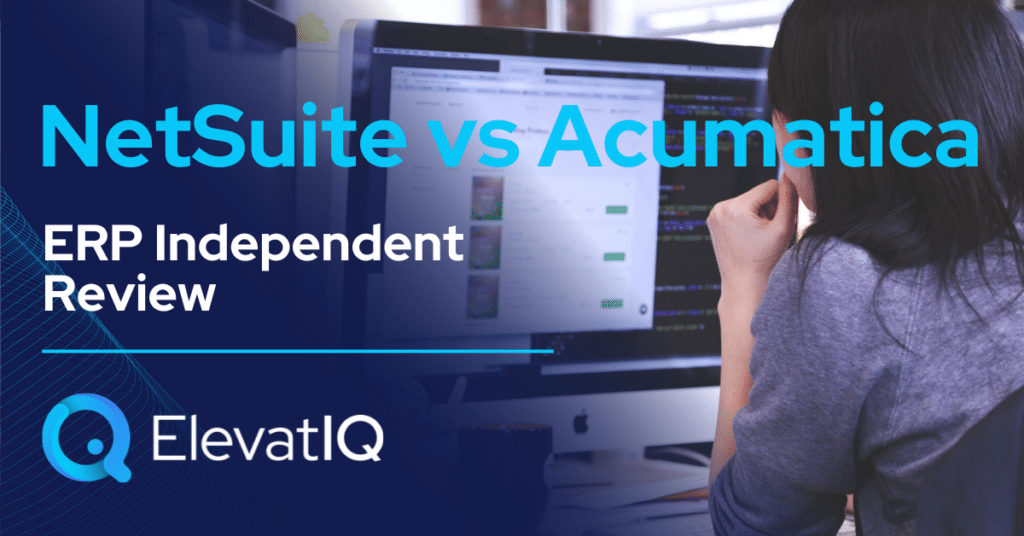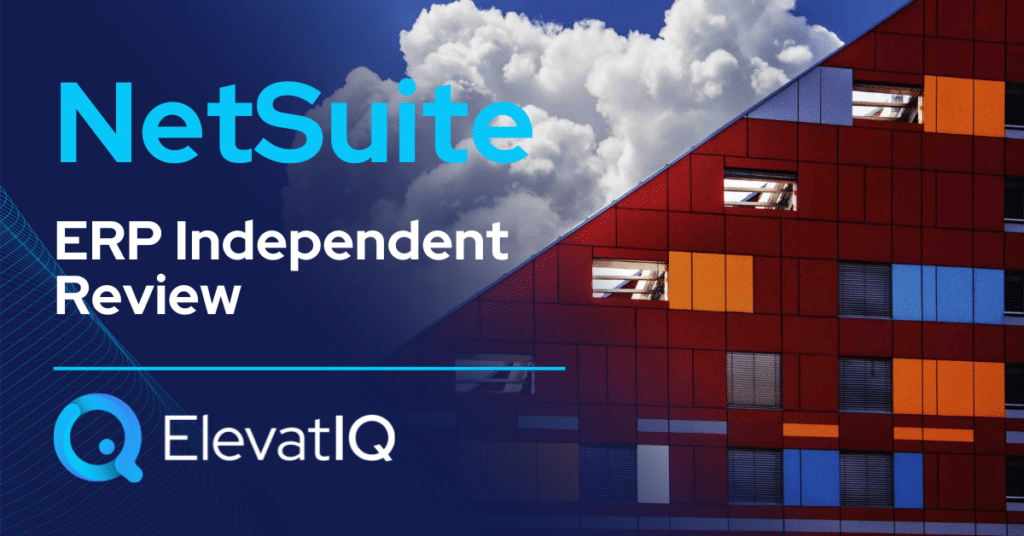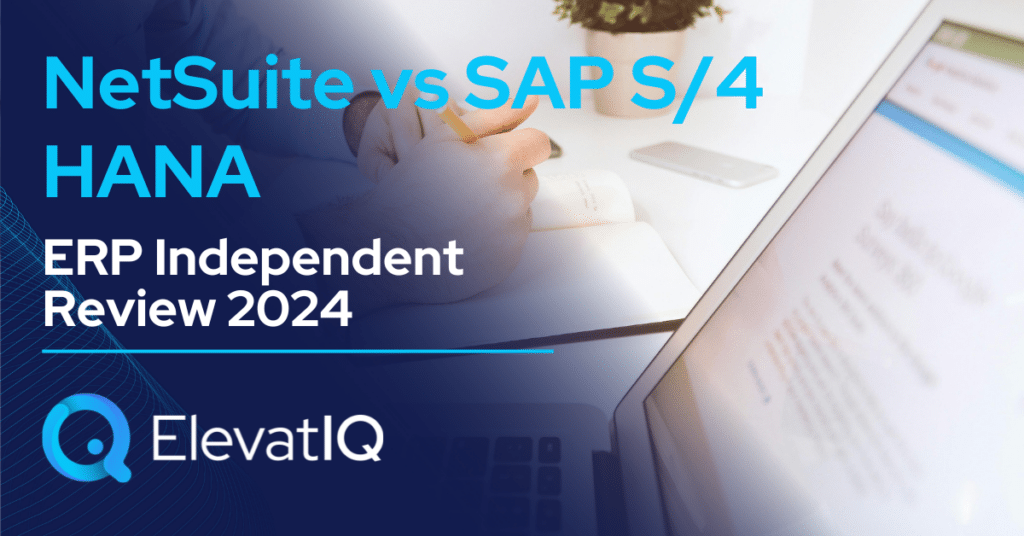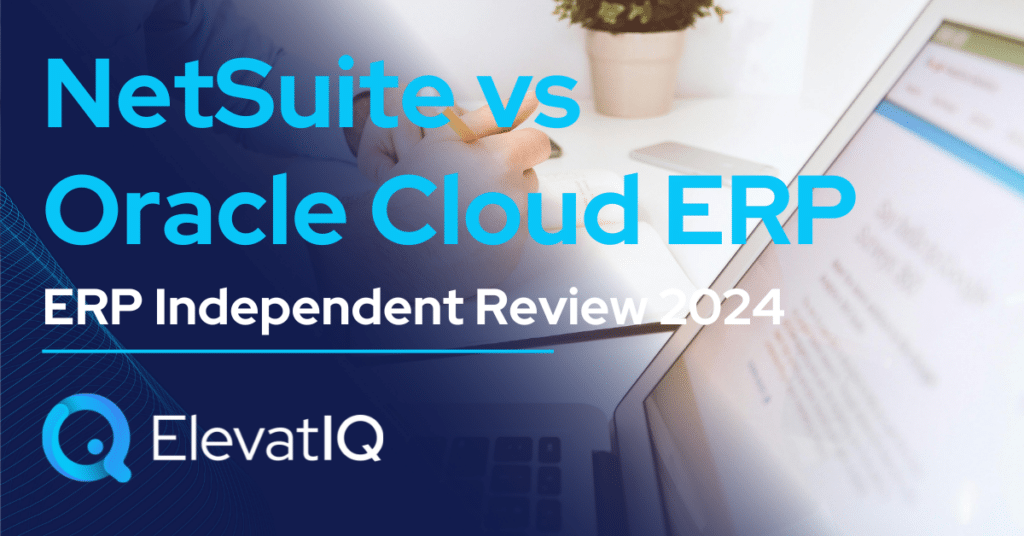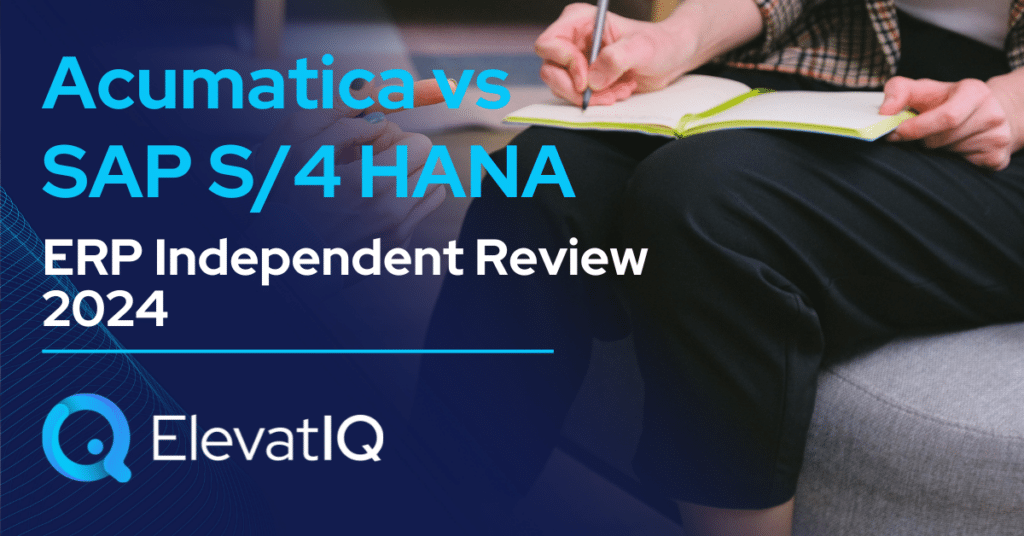NetSuite and Acumatica are among two of only three cloud-native ERP solutions. NetSuite is ideal for globally spread, small to mid-market companies seeking stronger financial capabilities with localization in many countries than operationally rich solutions for specific business models. Whereas, Acumatica is positioned as an ideal choice for companies within the $10-100 million revenue range, with limited native localization capabilities and synergies for global operations. NetSuite is also an ideal fit for diverse companies ranging from service-centric, distribution-centric, commerce-centric, and B2C organizations. On the other hand, Acumatica excels with its multi-branch capabilities and takes a different approach to supporting diverse business models such as manufacturing, distribution, construction, and field service.
While NetSuite excels across industries, it may not be the ideal choice for industrial distributors and manufacturers due to limited layers with pricing and item master. Its strength lies in supporting lighter manufacturing and consumerized products, particularly health and beauty, fashion, apparel, and CPG. On the contrary, Acumatica is an excellent initial system for companies looking to streamline inventory or costs despite limited capabilities with mature features like dimensional inventory or allocation.
Despite being the best cloud-native options, comparing their capabilities isn’t easy due to their overlap. Although, their marketing materials are likely to come across as very similar, comparing and contrasting requires a deep understanding of their data models. So if you have narrowed down your choices between NetSuite vs Acumatica, this comparison looks under the hood and provides crucial information for your ERP selection project. Let’s dive in?
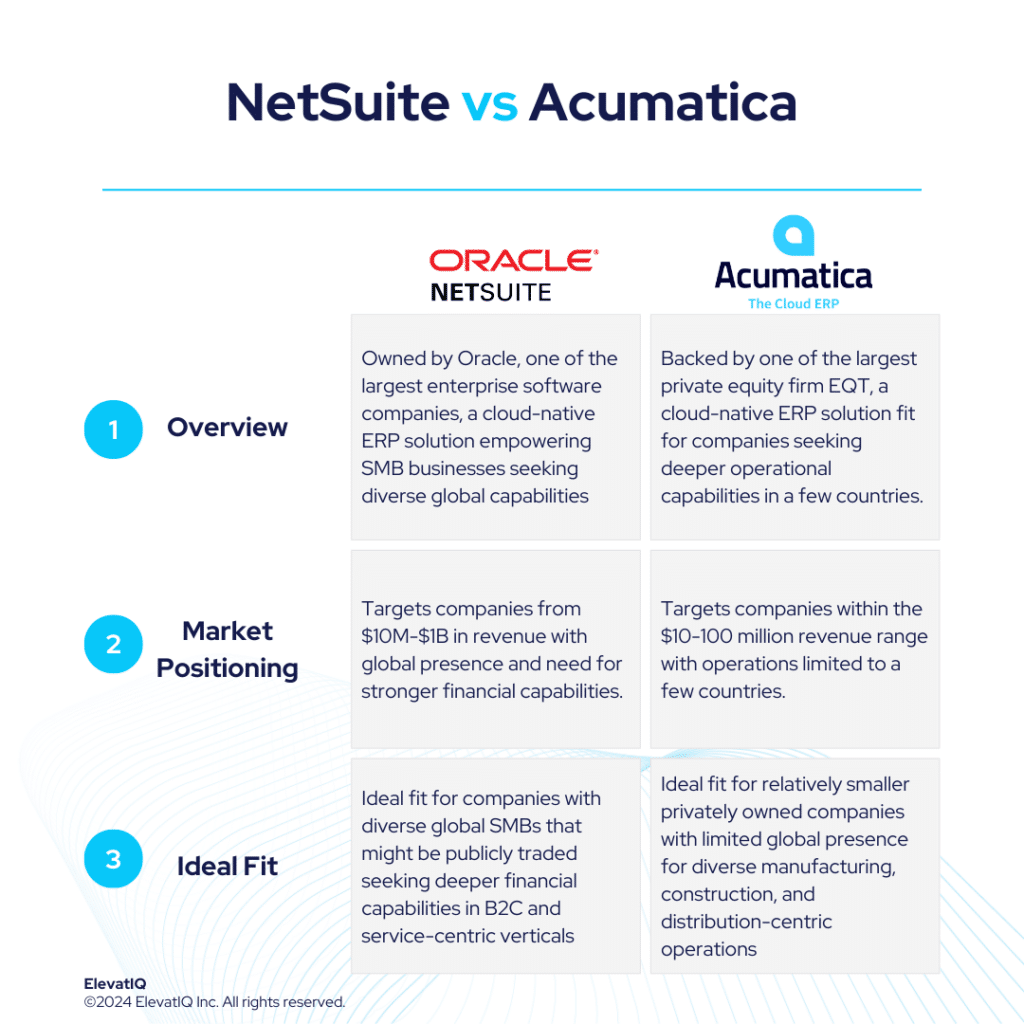

What is NetSuite?
NetSuite stands out as the leading ERP solution, driven by its success for diverse industries particularly seeking stronger financial capabilities over the operational, robust ecosystem, credible marketplace add-ons, and comprehensive functionality. Although not as complex as some competitors like SAP S/4 HANA and Microsoft F&O, NetSuite excels in supporting diverse business models, including omnichannel architecture, matrix/dimensional inventory, and subscription-based models.
While NetSuite excels across industries, it may not be the ideal choice for industrial distributors and manufacturers due to limitations in pricing and item master capabilities. Its strength lies in supporting lighter manufacturing and consumerized products particularly health and beauty, fashion, apparel, and CPG. With robust financial capabilities and an integrated HCM solution, NetSuite is well-suited for service-centric industries, including smaller banks, credit unions, financial services, non-profit organizations, as well as the technology and media sectors.
While NetSuite remains the top-ranked solution due to its product quality, there might be challenges with over-customization and integration issues, leading to implementation failures. Thus, working with NetSuite demands thorough vetting of their solution and architecture.
what is Acumatica?
Acumatica is one of three cloud-native ERP solutions similar to NetSuite and Sage Intacct. It has extensive multi-branch capabilities, particularly making it friendlier for retail-centric operations. It can also host multiple business models as part of the same database spanning manufacturing, distribution, construction, and field service. Thus, making it friendlier for diverse manufacturing or distribution-centric operations. Because of its limited global operational capabilities, it primarily targets US and UK-based companies. Thus, positioned as an ideal choice for companies within the $10-100 million revenue range, the majority of Acumatica’s customer base falls under this category.
Desiring a user experience akin to Odoo or Quickbooks, Acumatica ERP also offers versatility to accommodate various business models: distribution, manufacturing, or construction-focused. Although Acumatica has limitations in mature features like dimensional inventory or allocation, it is an excellent initial system for companies looking to streamline inventory or costs. With transactional processing and some mature capabilities, such as batch transactional processing, Acumatica is positioned as a valuable choice for businesses venturing into their first or second ERP solution.
Acumatica ERP is a fit for companies seeking cloud-native experience, particularly emphasizing features like enterprise search and mobility over deeper operational capabilities. Despite its focus on small businesses, Acumatica lacks robust globalization and localization features, catering to a limited number of countries by default. This simplicity, however, benefits smaller companies by avoiding unnecessary layers of multi-entity operations. Although targeting small businesses, Acumatica ERP surpasses Odoo or Zoho with the flexibility of its data layers, necessitating consulting help for implementation. The perceived benefit of Acumatica’s pricing is also a challenge, as it’s notoriously difficult to understand and predict.
| NetSuite ERP | Acumatica ERP | |
| Started in | 1998 | 2008 |
| Ownership/Backed by | Oracle in 2016 | EQT Partners in 2019 |
| No. of customers | 37,000+ | 10,000+ |
NetSuite vs Acumatica ERP Comparison
Navigating the choice between NetSuite vs Acumatica is a significant decision for businesses particularly looking for operational efficiency and strategic alignment. Thus, this section delves into the comprehensive comparison of NetSuite vs Acumatica across various critical dimensions.
| NetSuite ERP | Acumatica ERP | |
| Global Operational Capabilities | Can handle operations across 200 subsidiaries | Has limited multi-entity capabilities |
| Diverse Capabilities | Supports diverse business models with operations spanning multiple countries | Accommodates different business models spanning a few countries |
| Data Layers | Friendlier for B2C and service-centric operations | Richer than Odoo or Zoho, making it a great 1st or 2nd ERP choice |
| B2B Data Models and Processes | Not friendly for B2B companies as the pricing layers are not scalable as other systems | Attractive for B2B companies with complex customer hierarchies |
| B2C Data Models and Processes | Attractive for B2C companies because of its ecosystem | Has limited support to support the individual consumer processes and has a weaker ecosystem |
| Key Features | 1. Sales Order Management 2. Sourcing and Procuring 3. Warehouse Management 4. Production Management 5. Accounting | 1. General Ledger 2. AR and AP Management 3. Cash Management Integration 4. Tax Management Support 5. Deferred Revenue Accounting 6. Currency Management |
| Pricing Model | Named-user based | Consumption-based, named, and concurrent |
| E-Commerce Integrations | Marketplace options prevalent especially integration with omnichannel architecture | Offers native integration with eCommerce operations. Ideal for smaller companies with limited integration and consulting budgets |
| Manufacturing Capabilities | User feedback has concerns about perceived depth | Non-comprehensive and lacks ownership of key industry features such as quality |
| Integrated Capabilities | Focuses on seamless CRM integration. Great fit for businesses that are not planning to use a third-party best-of-breed solution | Focuses on its integrated WMS functionality. Great fit for businesses with complex product mixes and deep distribution requirements |
Pros of NetSuite vs Acumatica
When evaluating ERP solutions, understanding the distinct advantages of NetSuite vs Acumatica is crucial. In this section, we are particularly exploring the strengths of NetSuite vs Acumatica across various dimensions. Thus, shedding light on their respective capabilities and functionalities.
| NetSuite ERP | Acumatica ERP |
| 1. Provides richer financial capabilities over operational, requiring a higher implementation budget than Acumatica | 1. Great 1st or 2nd ERP choice due to stronger operational capabilities than NetSuite for industrial verticals |
| 2. Ideal for SMBs operating in different countries | 2. Accommodates different business models under one database |
| 3. The data model is B2C friendly, supporting integration with B2C channels | 3. The data model is B2B friendly, supporting complex hierarchies and pricing |
| 4. Ideal for eCommerce-centric SMBs because of the ecosystem and the integration operations available for eCommerce-centric companies | 4. Consumption-based pricing options reduce costs substantially for certain business models |
| 5. Ideal for companies looking to find best-of-breed software, along with NetSuite core capabilities | 5. Superior cloud-native UI experience as Acumatica has a more consistent design throughout application than NetSuite’s legacy and patchy experience, despite both being cloud-native |
Cons of NetSuite vs Acumatica
Just like recognizing strengths is important, it’s also crucial to weigh the specific drawbacks of NetSuite vs Acumatica. Therefore, in this section, we will delve into the limitations and challenges associated with NetSuite vs Acumatica across various operational and financial dimensions.
| NetSuite ERP | Acumatica ERP |
| 1. Not a great value for companies operating only in a few countries as they can get richer operational capabilities for particularly local operations with ERPs such as Acumatica | 1. Limited capabilities when multiple countries with different currencies and sub-ledgers need to be hosted as part of the same solution |
| 2. May struggle with transactional workload requirements of companies over $1B and the ones that might be acquiring 10-20 entities every year | 2. Not fit for companies with over $100 million in revenue |
| 3. Not ideal for startups with simpler operating models. They might find audit-centric and deep financial capabilities over-bloated | 3. The mobile capabilities are leaner for complex reporting scenarios such as parallel processing or reporting labor |
| 4. Named-user-based pricing requires allocating fixed costs, even for seasonal workers or external users accessing the subset of data such as customer or vendor portals | 4. Consumption-based pricing requires consulting expertise to estimate transactions as the pricing is not as predictable |
| 5. Not fit for companies seeking OEM-owned integration with core operational systems such as CAD or PLM | 5. Multiple add-ons such as MES, PLM, and quality, posing integration and communication challenges with the core systems required for complex manufacturing |
| 6. The last-mile capabilities required for manufacturing or industrial distribution are extremely limited | 6. The last-mile capabilities required for manufacturing or industrial distribution may not as strong as purpose-built solutions such as Infor or Epicor but stronger than NetSuite |
Conclusion
Navigating the complexities of NetSuite vs Acumatica requires a comprehensive understanding of the distinct advantages and limitations of each platform. While NetSuite might be a globalized solution suitable for companies seeking diverse global capabilities, it may not be the ideal choice for industrial distributors and manufacturers due to limited data layers. On the other hand, Acumatica shines with its multi-branch capabilities and flexibility to accommodate slightly deeper operational capabilities, making it a preferred option for retail-centric, manufacturing-centric, distribution-centric, and B2B organizations. However, both platforms face challenges with deeper last-mile capabilities that might be available with purpose-built solutions, but they might lead to pigeonholing with specific business models and operations. For this reason, thorough evaluation and consideration of individual business needs are critical before making a decision.
Therefore, engaging with an ERP independent consultant can greatly facilitate the decision-making process by providing expert insights and guidance tailored to the unique requirements of the business and how they align with the core strengths of these two products. Businesses can navigate the complexities of NetSuite vs Acumatica with confidence, also ensuring that they select the most suitable solution to drive operational efficiency and strategic alignment.



